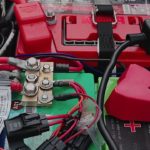Keeping Your Marine Batteries Charged
TNB’s Marine Tech consultant Darren Jacobson offers up some great advice on how to keep your marine batteries in tip-top shape.
 Each and every spring many anglers are faced with starting off the season with boat batteries that have failed! Whether from sheer age, neglect, or the fact that they were improperly maintained over the winter storage period, nothing puts a damper on the year’s first fishing outing faster than dead batteries. If you’re in the market for new boat batteries this season, I would like to review the various battery designs and the overall operation of today’s high tech onboard battery chargers, as well as focus on installation issues and the selection of a charger that will to fit your particular needs. That way, hopefully, you won’t have to suffer the pains of starting off another season dead in the water.
Each and every spring many anglers are faced with starting off the season with boat batteries that have failed! Whether from sheer age, neglect, or the fact that they were improperly maintained over the winter storage period, nothing puts a damper on the year’s first fishing outing faster than dead batteries. If you’re in the market for new boat batteries this season, I would like to review the various battery designs and the overall operation of today’s high tech onboard battery chargers, as well as focus on installation issues and the selection of a charger that will to fit your particular needs. That way, hopefully, you won’t have to suffer the pains of starting off another season dead in the water.
First, let’s take a look at today’s basic battery types. Gel Cell batteries have gained in popularity in recent years although the overall cost of such batteries are much greater than other types of batteries (Lead Acid for example). Lead Acid batteries are by far the most common type of battery. This type of battery houses lead plates in a solution of water and sulfuric acid. The chemical reaction that takes place produces electrons, which in turn produce the needed current.
With the use of your trolling motor or electronics the battery’s solution becomes weaker which means the battery is in the need of a recharging. By applying a charge to the battery, the solution will then become energized again and the reaction will start all over (producing electrons). The end result is a charged battery.
Delving further into the charging process, it’s important to realize that, if not done properly, this can do much more harm than good to your battery. The charging of a battery can be accomplished with a large variety of different types of chargers. In order to simplify things however, I would like to focus on one particular style of charger. This version should be considered as standard equipment for all anglers. I’m referring to Onboard Chargers! The onboard chargers of today are actually very smart pieces of electronic equipment … very smart! Onboard battery chargers go through a sophisticated series of steps to insure efficient and proper charging takes place every time you plug them in to juice up your batteries.
The first step in the overall process is the “quick charge” or “Bulk charge” depending on the manufacturers’ terminology. This step is responsible for bringing the battery to a 70% to 85% charge capacity and an overall voltage reaching 14.4volts. With the voltage reaching this level the charger will then tell itself to advance to the second stage of the process. In the second stage, often reffered to as the “Absorbtion” stage, voltage will hold at 14.4volts although the amperage will decrease until the battery reaches 95% to 98% of its overall capacity. Therefore, as the charger senses the overall charged level the next step will be triggered. The third and final step reflects a reduction of voltage and amperage. Generally, a good quality “smart charger” will decrease to the 13.4-volt range with 1 or less amps of current during this “maintenance” or “float” mode. Guest is one company that offers these kinds of quality “smart chargers” for today’s boater. Their chargers are designed in such a way that once they reach the “float” mode, they’ll maintain a 100% battery charge without any damaging affects on your batteries. I know this to be true because I conducted a little test of my own to verify the claim. During the winter months I do not remove the batteries from my rig, as many technicians recommend you do. My rig is stored in a heated building, maintained in the 42 to 45 degree range. During the storage season I plug my charger in from time to time for periods of up to several weeks. After this period of time I inspect the batteries by checking specific gravity and voltage. A very inexpensive hydrometer and a voltmeter will give you the charge status of your batteries. Specific gravity should read in the 1.26 range and the voltage should read 12.6 to 12.8 respectively. By following this simple process I have insured many years of service out of my batteries.
Ok, you have the basic understanding of the overall convenience and value of the onboard “SMART” chargers, but you still have reservations. Yes, I know the very questions that are going off in your head, like: Which model charger is right for my boat? Can I install it myself? What’s this going to cost me?
First I suggest contacting your local marine dealership. A quick conversation with your dealer will help give him an understanding of the best charger (or chargers) that will fill your needs. You may also utilize the experience of other anglers by using The Next Bite Forum Page to ask questions and get feedback from others that have dealt with many of these issues.
Onboard chargers typically come in one-bank, two-bank and three-bank models, with a few companies now producing four-bank chargers. Very simply, the banks refer to the number of batteries that the charger will handle at one time. The over all amp rating is the key in the recovery time of your batteries. For example the 10 amp three-bank charger will charge all three batteries at a 10-amp output. The recovery time will vary on the overall battery size and the level of charge remaining prior to recharging. At my dealership they install more 10 amp – three bank chargers than any other model. The main reason for this is the fact that 90% of the rigs on the water have one starting battery (12volt) and 2 trolling motor batteries (for 24 volt trolling motors). As I stated earlier, companies are improving chargers each year and the latest generations have the ability to detect the need for each battery individually and charge each independently.
The next major concern is the installation procedure. The general rule of thumb is to install the charger as close as possible to the batteries in question. Once the charger is installed you then simply connect the required terminal leads. If you have any concerns about doing your own charger installation, you may contact your dealer. Some charger manufacturers, such as Guest, offer online and phone assistance as well very high quality instructions with their units. Each charger comes with a normal 110volt molded plug so that once its installed, all you need to do is plug your extension cord in and your charger will be in operation. There is one more step you could take in the installation or your charger that really makes charging an easy operation. That is, add a remote receptacle in your boat for your extension cord to plug into. In many cases the best location for the charger is in a battery storage compartment or an adjacent location. By installing a remote receptacle you will eliminate the need to open any doors or lids to access the charger’s plug.
Onboard chargers range greatly in price since there are wide ranges of models to choose from. In many cases you can find chargers starting at around $70.00. Please take the time and choose the proper charger to meet all you current and future needs.





